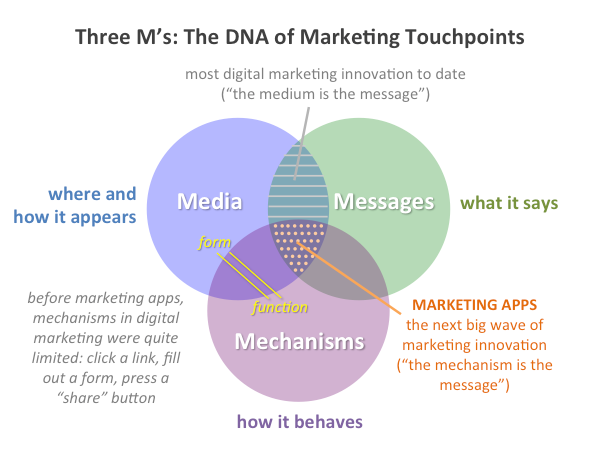Marketing Apps: Where Media, Messages & Mechanisms Converge
- Fahad H

- Apr 15, 2014
- 4 min read
One of the overarching trends in our industry is that marketing is shifting from being in the business of delivering communications — advertisements and content — to being in the business of delivering customer experiences.
It’s not just what we say. It’s what prospects and customers experience when they connect with us, in digital channels and in the physical world.
This is one of the seven meta-trends that I covered recently in my book, A New Brand of Marketing. It’s possibly the most transformative of all the changes that are rippling through our profession, because it fundamentally alters the way we need to think about what marketing produces.
We stop thinking in nouns, and we start thinking in verbs.
Nouns include ads, landing pages, white papers, ebooks, webinars, etc. They’re static content. They have no motion, no movement. They’re inert. When people talk about “dynamic content,” they usually just mean that they’re using some kind of personalization algorithm to determine which piece of static content to show someone.
Verbs, on the other hand, have velocity. They’re how people flow through our website. They’re the sequence of steps that prospects take to learn about what we can offer them. They’re interactive, such as a conversation with a great salesperson. They’re truly dynamic, because what a user does at one step in the process affects what they experience at the next step along that journey.
Content marketing thinks in nouns. User experience design, in contrast, thinks in verbs.
Apps Aren’t Just For Smartphones & Tablets Anymore
Over the past year, I’ve been fascinated by this shift from content to experiences appearing in more top-of-funnel marketing activities with things that I call “marketing apps.”
What’s a marketing app? It’s an app-like web experience, such as a contest, a wizard, a quiz, a configurator, a game, an interactive white paper, an assessment tool, a calculator, etc. Rather than just present a user with static content for them to passively consume, a marketing app engages them in an interaction.
I think of them as apps because, in many ways, they share much of the same DNA as native smartphone apps, such as on Android and Apple devices. Smartphone apps helped pioneer the shifting of customer expectations. A company who wants to build a relationship with their audience in the digital world must provide something useful. (This is an idea that Jay Baer has championed magnificently in his book Youtility.)
Marketing apps simply take that core concept and make it more ubiquitous. They’re built for the responsive web, so they can work on any device — smartphone, tablet, laptop, desktop, wristwatch, etc. They don’t require a visitor to install anything. They simply slip into the user’s experience when they visit your website or landing page.
Media, Messages & Mechanisms
What excites me about marketing apps is that they open up a new vector of innovation in marketing.

Courtesy of ioninteractive.com
I believe that marketing touchpoints are the intersection of three things: media, messages, and mechanisms. Messages are what we say. Media are where and how those messages appear. Mechanisms are how that touchpoint behaves — what the recipient can do.
Media are mostly about form. Mechanisms are more about function.
Back to our original metaphor: messages are nouns, while mechanisms are verbs.
While there have been several innovations in mechanisms in digital marketing — “social sharing” was a huge new kind of mechanism introduced into marketing touchpoints — most of the innovations that have received attention in marketing have revolved around the intersection of media and messages.
“The medium is the message” is the classic battle cry for creatively leveraging where and how something appears as an integral part of the message being communicated. Much of the (good) advice you get about what to publish in social media channels — what’s appropriate, what resonates — falls into this category.
Before this new wave of marketing apps started appearing, however, innovations with mechanisms have been few and far between. For instance, in landing pages, 95% of them incorporate only one simple mechanism: fill out a form and click a submit button. That’s become a very tired, old mechanism.
An Era Of New Marketing Touchpoint Mechanisms
Now, we’re seeing many interesting new kinds of mechanisms appear.
For instance, with an interactive white paper, someone doesn’t just download a big static PDF. Instead, the white paper is transformed into more of an interactive experience. Readers click to jump from one topic to another, to quickly zoom in on the material that is most relevant to their interests. They might engage in a little quiz to test their assumptions — and then be guided to the section that best addresses their needs at an appropriate level. They may participate in a poll to see how their views compare with those of other readers.
There is so much opportunity to unlock new marketing creativity here.
Disclosure: recognizing this powerful trend, my company, ion interactive, has recently pivoted to focus exclusively on providing a platform for marketing apps. However, none of the ideas that I’ve described above are in any way dependent on software from us. There are many other great companies that are offering marketing apps technology too, such as SnapApp, Ceros, Offerpop, Wishpond, and more.








Comments